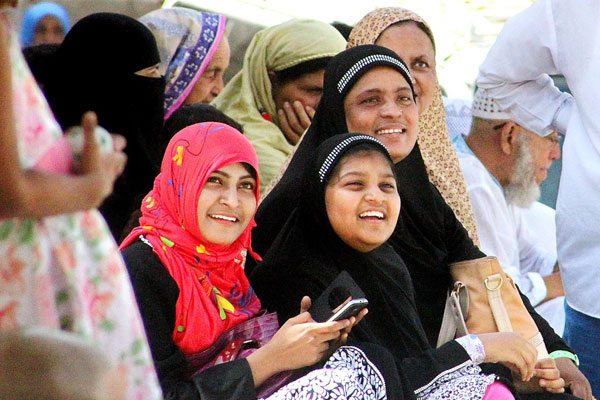
August 22, 2017; Al Jazeera and National Public Radio, “The Two-Way”
After nearly four months of testimony and debate, India’s Supreme Court’s ruling joins majority Muslim countries of Saudi Arabia, Bangladesh, Morocco, Afghanistan and Pakistan in banning the practice of triple talaq.
The practice of triple talaq allows Muslim husbands to dissolve their marriages in a moment by simply repeating “talaq,” the Arabic word for divorce, three times. (Some men have reputedly done this over the phone or via text message.) Triple talaq has been described as the worst form of marriage dissolution, an un-Islamic practice, and an instrument to oppress women.
Success in banning the practice is attributed to the two-year lobbying effort by women and their organizations, spearheaded by Bharatiya Muslim Mahila Andola (BMMA). The effort also gained the support of the country’s prime minister, Narendra Modi. Another factor is recent events in the country highlighting the status of women. The propensity for and brutality of rape has brought women’s issues front and center and in international news. More recently, eyebrows were raised when Air India was forced to create female only seating in response to complaints of groping and indecent touching of female passengers by their male counterparts. Critics wondered if this was the airline’s strategy to further isolate Indian women from the mainstream. A five-member bench ruled three to two against triple talaq. Of those who ruled to ban the practice, one described it as alien to Islam and therefore not protected under the India’s constitutional protection of freedom of religion.
The court noted that “the Quran had attributed ‘sanctity and permanence to matrimony’ and encouraged reconciliation between couples. But the court said with ‘triple talaq,’ which amounts to instant divorce, ‘this door is closed.’”
The other two did not take a religious stance, but stated that triple talaq violated Indian women’s Article 14 right to equality. Advocates pointed out that the law drastically reduces female economic standing and contributes to domestic violence. India’s Supreme Court has 28 sitting judges, of whom only one, R. Banumathi, is a woman. She did not participate in the case.
One impetus behind the court case was a multiple-year struggle by women in India. In March of this year, in an unprecedented show of unity and support, over one million Indians, mostly women, signed a petition to the Supreme Court that jumpstarted the process. Though this might appear a small percentage in the face of India’s 90 million women, given decades of inequality and domestic and sexual violence, particularly for lower caste females, this was courageous and monumental. As outlined by NPR’s Julie McCarthy,
Zakia Soman, co-founder of the Indian Muslim Women’s Movement, states, “Many women want to stay in unhappy marriages to avoid becoming destitute. These women seek to keep ‘the status of wife’ because they are so vulnerable.”
Sign up for our free newsletters
Subscribe to NPQ's newsletters to have our top stories delivered directly to your inbox.
By signing up, you agree to our privacy policy and terms of use, and to receive messages from NPQ and our partners.
Soman calls talaq a “sword hanging over a woman’s head,” and says domestic violence and the male prerogative to declare instant divorce are intimately linked. […] Frequently, the husband threatens, “Do this, or I’ll talaq you! Don’t do that, otherwise I’ll talaq you.”
In the same article, Soman references her organization’s 2015 survey which discovered that one in every 11 women has had their marriage ended by talaq. Of those divorced women, fewer than five percent ever gets any financial support.
Another tipping point, like many issues today, was technology. Not only was the practice unusually cruel, but the advent of social media resulted in instant divorce by Skype and WhatsApp.
Though triple talaq had been decreed unconstitutional before in 2015, this recent decision not only requires legislators to develop new regulations on marriage and divorce within six months, but also enjoins husbands from using triple talaq.
Although the ruling is far from settled law, women in India are encouraged because it emanates from India’s highest court. Prior to the Supreme Court ruling, lower courts eschewed court intervention, instead opting to leave it in the hands of the clergy. Muslim women in India are governed by the Muslim Personal Laws, as administered by the All India Muslim Personal Board (AIMPLB), meaning that policy was governed by the religious leadership.
AIMPLB, for its part, still isn’t budging. The AIMPLB belief is that for Muslim women in India, the church is the state. They cautioned the Supreme Court “not to meddle with its personal laws,” as it’s not their legal purview. According to Al Jazeera, “India’s Muslim Law Board had told the court that while they considered the practice wrong, they opposed any court intervention.” The women felt they had waited far too long; hence the recent concerted push.
This division between the secular and religious world has left some skeptical as to the eventual impact of the ruling. As Faizan Mustafa, the vice-chancellor of NALSAR University of Law in Hyderabad and a leading expert on constitutional law, said in an interview with Al Jazeera, “Court judgments do not bring about social reforms. Now, the only thing is if a Muslim male does triple talaq and if the wife goes to the court, the court won’t recognize the divorce. Now, will the girl go back [into the marriage]? In this case, the leading petitioner in a current case, Shayara Bano, just told NDTV network that she is not going back to her husband because he has taken another wife even though the divorce has been held unconstitutional or invalid in law. Marriage is a relationship of love; the courts cannot force you to love each other.”—Mary Frances Mitchner













